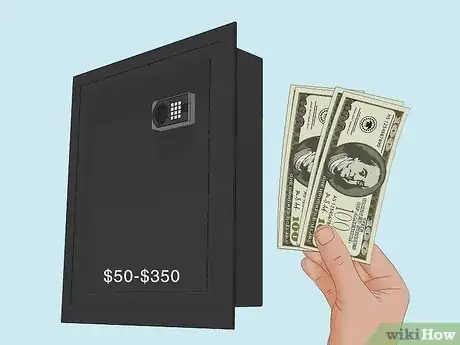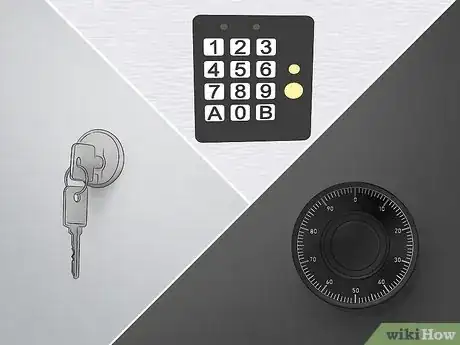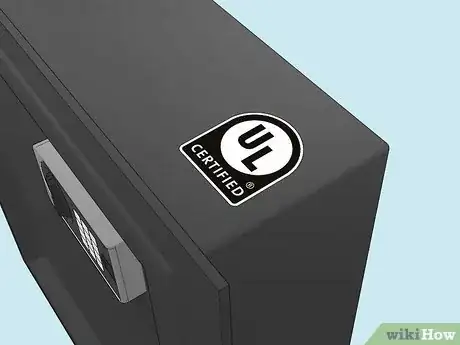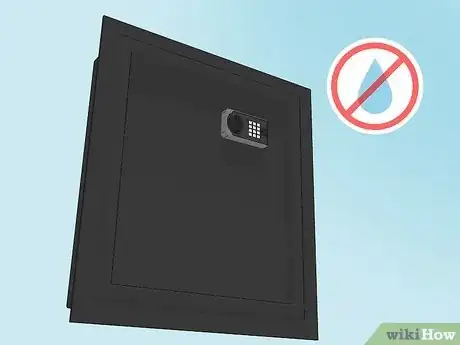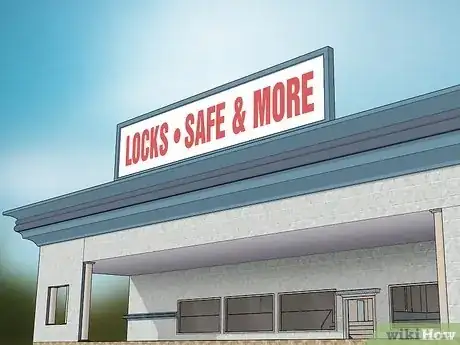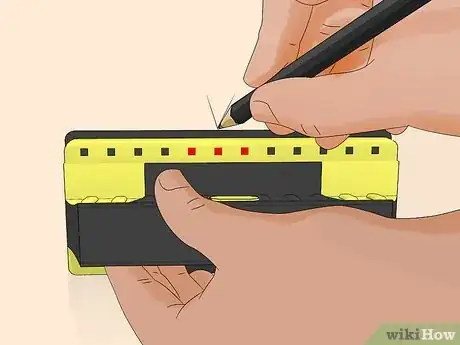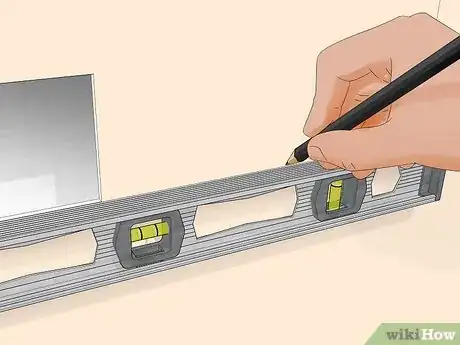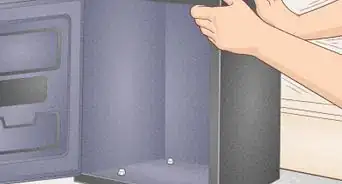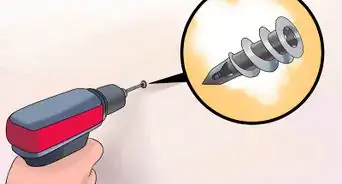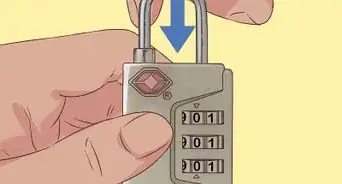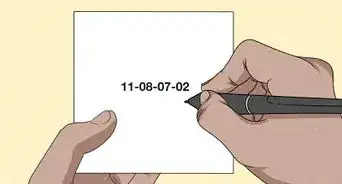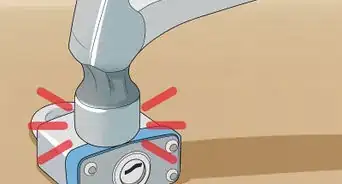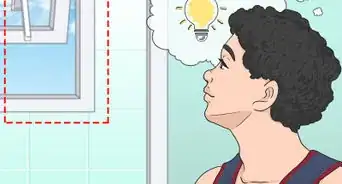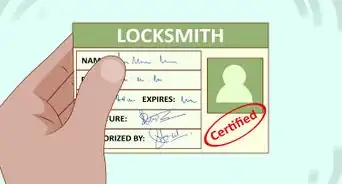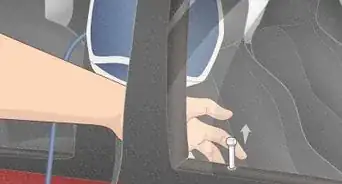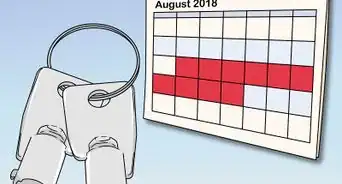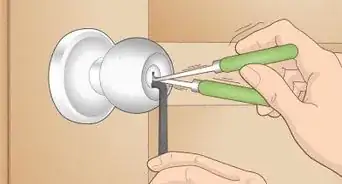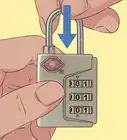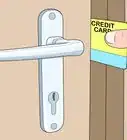wikiHow is a “wiki,” similar to Wikipedia, which means that many of our articles are co-written by multiple authors. To create this article, volunteer authors worked to edit and improve it over time.
This article has been viewed 62,901 times.
Learn more...
A wall safe can be a handy way to hide away valuables in a secure place. Installing a safe is a relatively simple home project. However, if you install it incorrectly criminals can simply cut out the safe and take it with them. By following a few steps you will have a safe and secure location to place your valuables.
Steps
Preparing to Install a Wall Safe
-
1Budget for your safe. Wall safes cost between $50-$350 on average but some will be even higher priced. For a decent safe you can budget between $150-300 but the actual price will depend on the features and size you want.
- Different security features and fireproofing abilities can increase the cost of your chosen safe.
-
2Figure out the correct size. Most homes are built from two-by-fours (44 x 94mm) spaced 16 inches (40.5 cm) apart. This means that the typical safe will have to fit in this space. Look for a wall safe with a width of less than 16 inches (40.5 cm) and depth of 3.5 inches (9 cm). You can then chose the height that you prefer in which to fit your belongings.
- Check the size of your walls if you feel they do not agree with these average measurements by finding the studs in your walls.
Advertisement -
3Choose a wall safe with fire resistance. Fire resistant safes will protect your valuables and papers in the event of a fire. Both Underwriters Laboratories (UL)[1] and Intertek (ETL) [2] are independent organizations that rate wall safes according to fire resistance. If you want a fire resistant wall safe choose one that will protect your goods for at least 30 minutes because most fires move through a room in about 20 minutes.
- UL and Intertek rate wall safes according to the type of material they will protect and the length of time they will provide protection. Look on the safe itself or the packaging for these ratings.
- Choose the wall safe with a fire protection rating according to what you would like to protect. Papers should not get hotter than 350 degrees F (176 degrees C), old tape recordings or 35mm slides no hotter than 150 degrees F (65 degrees C) and CDs/DVDs no hotter than 125 degrees F (52 degrees C).[3]
- In Europe the Eurograde system evaluates wall safes.
-
4Decide which access control features you would like. Access control features may include a combination, a key, both a key and pin code or biometric data such as a fingerprint. All access methods are fairly effective and depend on the user to maintain their effectiveness.
- If you are using a wall safe as a gun safe then it might be preferable to choose biometric access to prevent a key or code from falling into the hands of children.
-
5Check theft resistance ratings. Some but not all wall safes have been tested for burglary resistance. Again check for the UL label. A safe rated B4 then it would be able to withstand an attack of at least 15 minutes using common tools.
- Most burglaries take around 8-12 minutes so a wall safe with this rating would be safe during this time.
- Ratings of B1, B2 or B3 mean the safe provides very little security and resistance to tools.
- A B5 rating means the safe can withstand 30 minutes of a typical attack with common tools while a B6 rating means the safe can withstand 30 minutes of attack with common tools, torches and carbide-tipped tools.[4]
-
6Decide if you want water resistance. Water resistance ratings are also performed by Intertek and will be marked “verified” if they meet criteria. These safes would protect valuables in case of a flood or broken water line.
-
7Buy your safe from a store that specializes in safes. Safes can be purchased from many hardware stores as well as online marketplaces. Buying a wall safe from a shop that specializes in safes can give you the opportunity to speak to an expert regarding the options that would work best for you.
-
8Find the right location. Choose a location that is accessible so that you can use the safe effectively. Additionally the safe should be out of the regular traffic pattern of the house such as a closet, the laundry room, behind a heavy piece of furniture, behind a bookcase filled with books or in a child’s room. This makes the wall safe less noticeable and obvious to potential intruders.
- The location will also depend on the studs in your wall. Make sure you choose a location which will be able to make use of the space between studs.
Installing a Wall Safe
-
1Locate your studs. [5] You will want to fix your safe between studs to allow it to be recessed inside your wall and thus less noticeable. Use a stud finder to locate the studs behind the wall by running the stud finder across your wall. The tool will have an indicator to show when it has found a stud.
- Stud finders can be purchased from your local hardware store.
- If you don’t have a stud finder you can knock on the wall and listen for a hollow or solid sound. If the sound is hollow then the location is probably between studs; if it sounds solid then there is likely a stud in this location.
- Knock a nail into the wall. As you hammer you will be able to feel if you hit a stud by the way the nail goes into the wall. These holes will be covered once you have installed your wall safe.
-
2Mark your studs. Use a pencil to mark the locations of the studs on the wall. This will help orient your lines when you cut out the section of the wall.
-
3Cut out a small square of space using a drywall saw.[6] After you’ve found a good safe and a place to install it between studs, you are ready to cut into your wall. Cut out a small square of space big enough for your hand to fit through.
-
4Reach into the space with your hand to feel for electrical wiring or plumbing. If you find wires you need to be extra careful to go around them or reroute them. If you find plumbing in the way you may need to find a new location. If the wall is clear, you are ready to cut out a space for your safe.
- If something is in the way and you are not confident in your ability to safely move or go around it, the best option is to find a new section of wall.
-
5Measure the wall to mark the size hole needing to be cut for the safe. Mark the four corners of your square hole using a pencil. Use a level to make level lines between the four corners. It is essential that the top and bottom are parallel with the ground while the sides are parallel with your studs.
- The hole should be close enough to a stud so that you can attach it to your safe later.
- Make sure to measure and level correctly so that you don’t end up with an uneven or wrongly sized hole.
-
6Cut along the marks to create a hole in the wall. Use your drywall saw to cut along the marked lines. Start with the bottom edge of the opening and then cut the sides. You should cut the top line last to make sure the piece does not fall out beforehand, creating an uneven line.
-
7Slide your safe into the hole. Put your safe into the hole, remembering to keep it help up with your hand. The door is the heaviest part of the safe due to the locking mechanism so be careful to hold up the corner so that it doesn’t fall out on you.
-
8Fix the safe to the studs by drilling through the holes in the sides of the safe. Drill holes into the sides that match with the holes on the interior of your safe. Drill in each screw and then tighten them firmly.
- This is an important step that prevents burglars from simply cutting your safe out of the wall and walking away with the whole thing.
-
9Insert the shelves. Place the shelves inside the safe in their desired locations, making sure you line them up correctly. Some shelves will have cutouts to make space for the door locking mechanism and door hinges; make sure these cutouts are in the correct locations.
Community Q&A
-
QuestionHow do I anchor between steel studs?
 Community AnswerUsing a drill and the right-sized bit to pre-drill holes, you can use sheet-metal screws instead of nails.
Community AnswerUsing a drill and the right-sized bit to pre-drill holes, you can use sheet-metal screws instead of nails. -
QuestionHow do I install a wall safe if my studs are too close together?
 C GraceCommunity AnswerAs the article states, your studs should be 16" apart, which is standard. If not, then just measure between them and look for a safe that will fit. If there are none that fit, then you will have to look for a different wall that will accommodate a safe, or just give up on the idea.
C GraceCommunity AnswerAs the article states, your studs should be 16" apart, which is standard. If not, then just measure between them and look for a safe that will fit. If there are none that fit, then you will have to look for a different wall that will accommodate a safe, or just give up on the idea.
Warnings
- Installing a wall safe can be quick and simple. However, if you have little handiwork experience, consult an experienced (and trusted) handyman.⧼thumbs_response⧽
Things You'll Need
- Stud Finder (if necessary)
- Pencil
- Measuring Tape or Ruler
- Level
- Power Drill
- Drywall Saw
References
- ↑ https://www.ul.com/news/personal-safe-sales-rise-how-safe-are-they
- ↑ https://www.intertek.com/marks/etl/
- ↑ http://www.consumerreports.org/cro/2011/01/choosing-and-using-a-home-safe/index.htm
- ↑ http://www.consumerreports.org/cro/2011/01/choosing-and-using-a-home-safe/index.htm
- ↑ https://www.youtube.com/watch?v=5YKmNDmKXVo
- ↑ https://www.thisoldhouse.com/home-safety/21016342/how-to-install-a-wall-safe
About This Article
To install a wall safe, start by locating the studs behind the wall with a stud finder and marking their locations with a pencil. Next, choose a position between 2 studs and use a drywall saw to cut out space in the wall according to the dimensions of your safe. Then, slide the safe into the hole and secure it to the studs on either side with drill. Finally, install any shelving that came with your wall safe before storing your items inside. For more tips on working around wall studs, read on!
